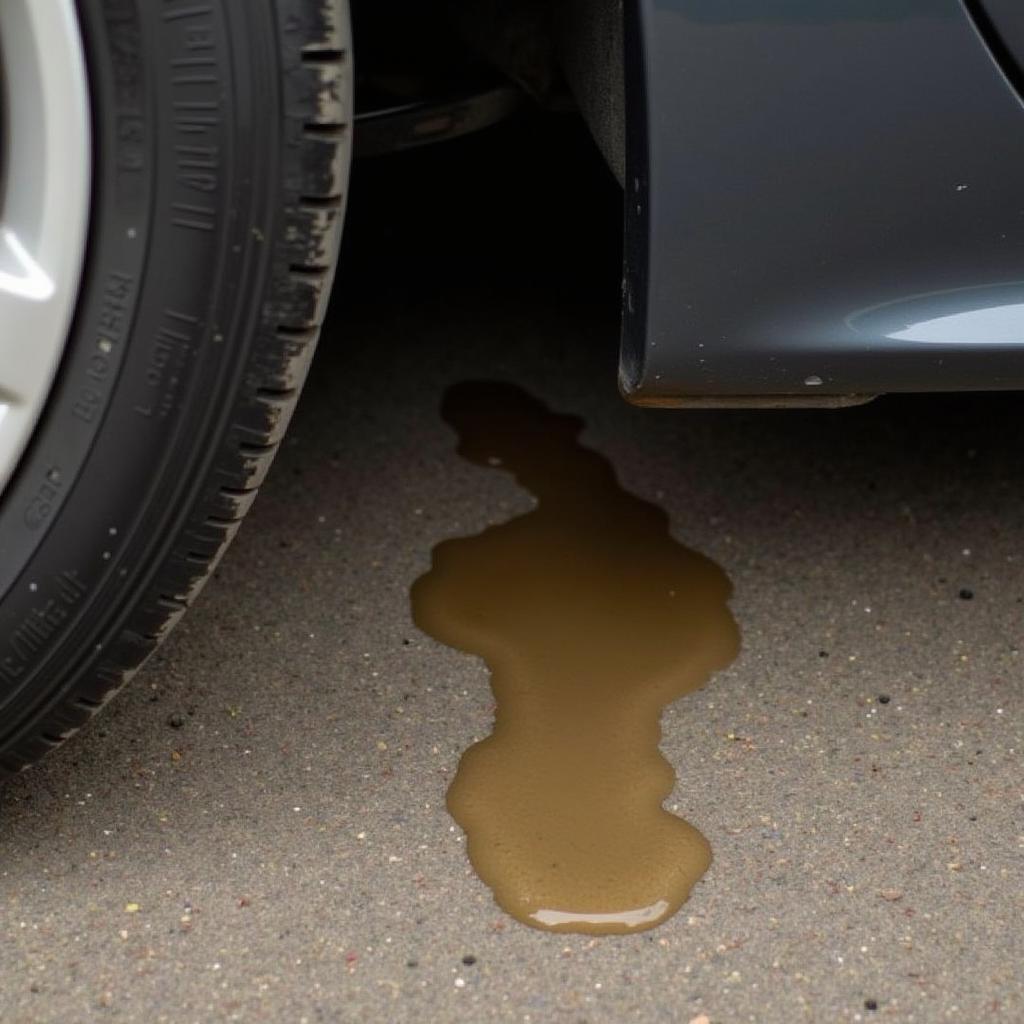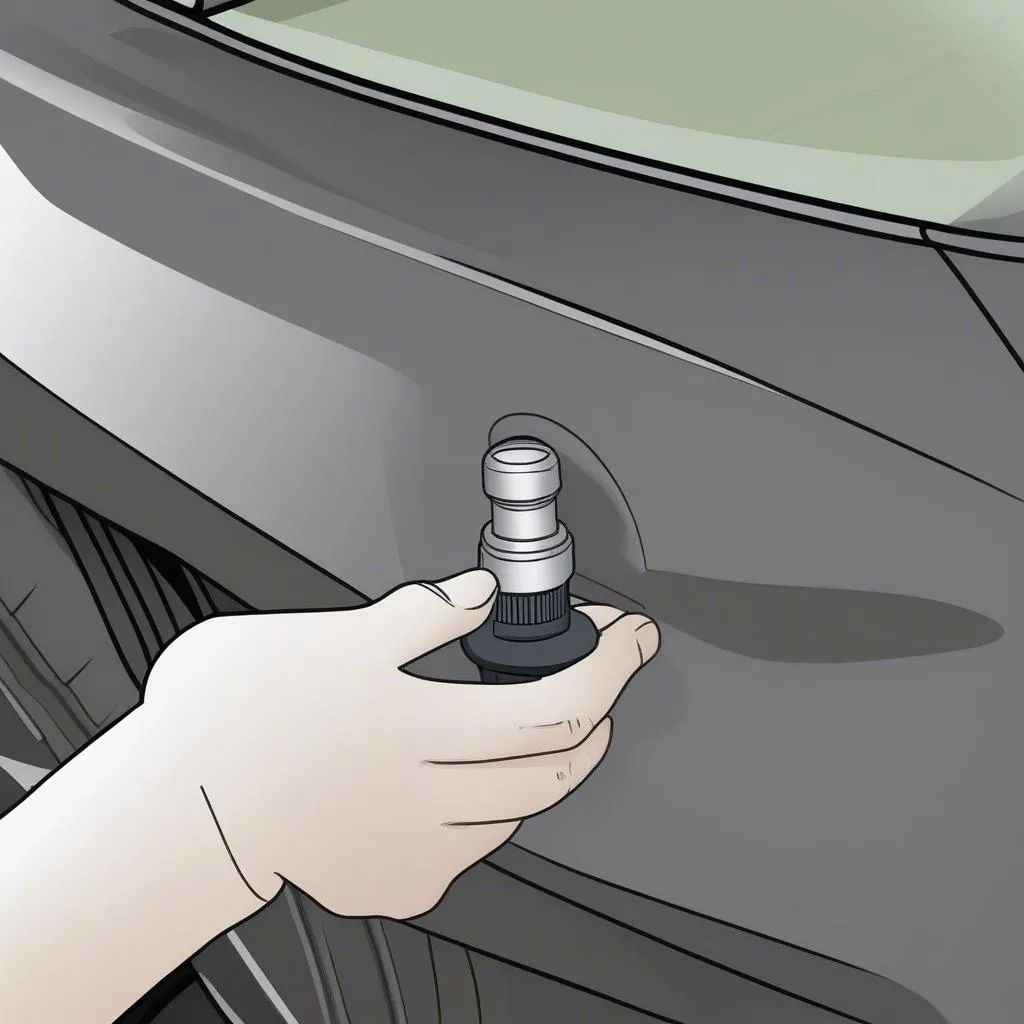The brake fluid warning light on your Audi TT dashboard is a crucial safety indicator. When illuminated, it signals a potential problem within your vehicle’s braking system that requires immediate attention. Ignoring this warning light can lead to decreased braking performance and potentially dangerous driving situations.
Understanding Your Audi TT’s Brake System
Before diving into the causes of the brake fluid warning light, it’s helpful to understand the basics of your Audi TT’s braking system. This system is comprised of several key components working together to slow down or stop your vehicle:
- Brake Fluid: This hydraulic fluid transmits force from the brake pedal to the brake calipers at each wheel.
- Master Cylinder: This component pressurizes the brake fluid when you press the brake pedal.
- Brake Lines: These lines carry the pressurized brake fluid to the wheels.
- Brake Calipers: The calipers house pistons that push the brake pads against the rotors to create friction and slow the vehicle.
- Brake Pads and Rotors: These components create friction to slow or stop the wheels when in contact.
Common Causes of the Brake Fluid Warning Light
There are several reasons why your Audi TT’s brake fluid warning light might be on. Some of the most common causes include:
- Low Brake Fluid Level: This is the most common reason for the warning light to illuminate. Brake fluid levels can decrease over time due to wear and tear on brake pads, leaks in the brake lines, or a failing master cylinder.
- Worn Brake Pads: As brake pads wear down, the brake calipers need to extend further to engage the rotors. This process requires more brake fluid, potentially triggering the warning light.
- Brake Fluid Leak: A leak anywhere in the brake system, including the lines, hoses, or connections, can lead to a drop in brake fluid level and activate the warning light.
- Faulty Brake Fluid Level Sensor: The sensor itself can malfunction, sending a false signal to the dashboard even if the brake fluid level is adequate.
Diagnosing the Issue
1. Check Your Brake Fluid Level:
- Park your car on a level surface and engage the parking brake.
- Locate the brake fluid reservoir under the hood. Refer to your owner’s manual for its exact location.
- Carefully remove the reservoir cap.
- Visually inspect the brake fluid level. It should be between the minimum and maximum markings on the reservoir.
2. Inspect for Leaks:
- If the fluid level is low, carefully examine the area around the reservoir and under the car for signs of leaks. Look for wet spots, drips, or puddles of brake fluid.
 Identifying a Brake Fluid Leak on an Audi TT
Identifying a Brake Fluid Leak on an Audi TT
3. Check for Worn Brake Pads:
- If the brake fluid level is adequate, visually inspect your brake pads through the spaces between the wheel spokes.
- Thin brake pads or pads with less than ¼ inch of friction material remaining require immediate replacement.
What to Do When the Warning Light Comes On
If your Audi TT’s brake fluid warning light illuminates, it’s crucial to address the issue promptly:
- Pull over safely: Find a safe location to pull over as soon as possible. Driving with low brake fluid or a compromised brake system is extremely dangerous.
- Do not continue driving: Continuing to drive with a brake fluid warning light can lead to further damage to your brake system and increase the risk of an accident.
- Contact a professional: Unless you are confident in your mechanical abilities and have experience working with brake systems, it’s best to have a professional diagnose and repair the issue.
Remote Diagnostics and Software Solutions
In some cases, remote diagnostics and software solutions can be used to diagnose and resolve issues related to your Audi TT’s brake fluid warning light.
For instance, if a faulty brake fluid level sensor is suspected, a remote technician can connect to your car’s onboard diagnostics system to confirm the diagnosis. They can then reset the sensor or provide guidance for replacing it.
However, it’s important to note that remote solutions are not always feasible for all brake-related problems. Physical inspection and repairs by a qualified technician are often necessary.
Preventative Maintenance for your Audi TT’s Braking System
- Regular Brake Fluid Flushes: Consult your Audi TT owner’s manual for the recommended brake fluid flush interval. Regular flushes help maintain the fluid’s effectiveness and prevent corrosion within the braking system.
- Timely Brake Pad Replacements: Replacing worn brake pads before they reach a critically low level will help maintain optimal braking performance and prevent damage to the rotors.
- Annual Brake Inspections: Include a thorough inspection of your Audi TT’s brake system during routine maintenance. This allows for early detection and repair of potential issues.
Conclusion
The brake fluid warning light in your Audi TT is a serious safety concern that should never be ignored. By understanding the common causes, taking appropriate action when the light comes on, and following preventative maintenance guidelines, you can help ensure the safety and reliability of your vehicle’s braking system.
Expert Insight: “Ignoring a brake fluid warning light is like ignoring a flashing ‘check engine’ light while driving uphill – you’re putting yourself and others at risk. Regular maintenance is key to preventing brake system failures.” – John Miller, ASE Certified Master Technician
brake pads warning light audi tt
Frequently Asked Questions
1. Can I add brake fluid myself if the level is low?
While it’s possible to top off brake fluid, it’s essential to determine the underlying cause of the low level first. Adding fluid without addressing the root problem won’t solve the issue and could be dangerous.
2. What type of brake fluid does my Audi TT use?
Your Audi owner’s manual will specify the correct type and specification of brake fluid for your specific model. Using the wrong type of brake fluid can damage your braking system.
red brake warning light on audi a6
3. How long can I drive with the brake fluid warning light on?
You should never drive with the brake fluid warning light on. Pull over safely and contact a professional as soon as possible.
4. Is it safe to drive with worn brake pads?
Driving with worn brake pads significantly reduces braking performance and increases the risk of an accident. Replace worn brake pads immediately.
5. How much does it cost to fix a brake fluid leak?
The cost of repair depends on the location and severity of the leak. Minor leaks might involve replacing a hose or seal, while a major leak could require replacing entire components like the master cylinder.
6. Can extreme temperatures affect my brake fluid?
Extreme heat can cause brake fluid to boil, reducing its effectiveness. Similarly, extremely cold temperatures can thicken brake fluid, making it sluggish.
7. How often should I have my brake system inspected?
It’s recommended to have your brake system inspected annually or more frequently if you drive in harsh conditions or notice any changes in braking performance.

